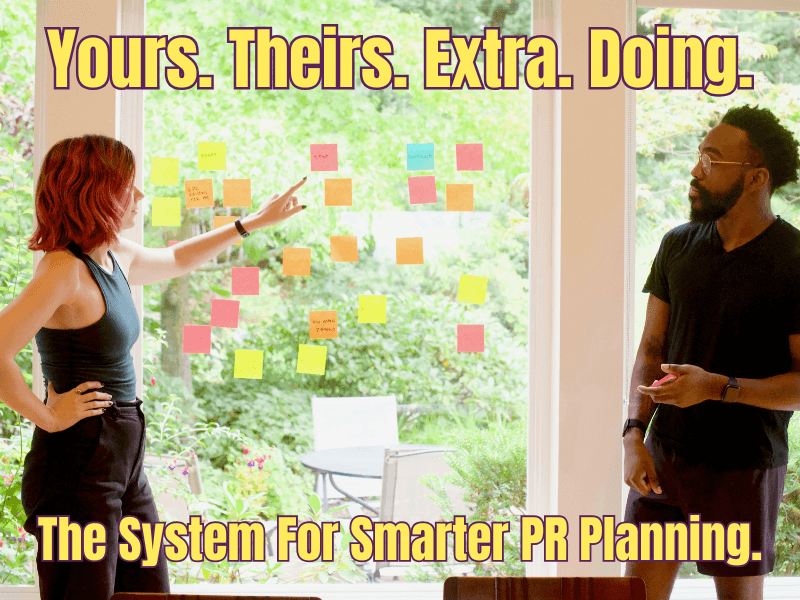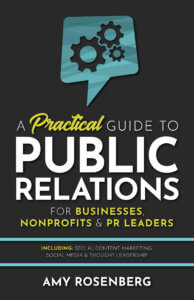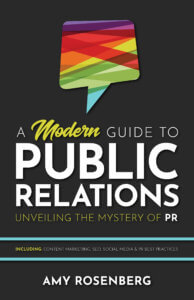Every great owned and earned marketing program starts with a plan — but too often, planning feels overwhelming. Where do you start? How detailed should it be? And how do you make sure your calendar doesn’t just become another spreadsheet graveyard?
The best plans don’t have to be complicated. They just need to give a clear picture of what’s coming up. For clients, Veracity uses a simple grid format — usually a Google Sheet — to view months side by side. This makes it easy to see what’s ahead, spot opportunities and keep efforts consistent.
My second book, A Practical Guide to Public Relations, explains plan creation using a system that I’ve attempted to summarize here. Our plans are organized by sections called Yours, Theirs, Extra and Doing. This Plan Template will help you visualize this system.
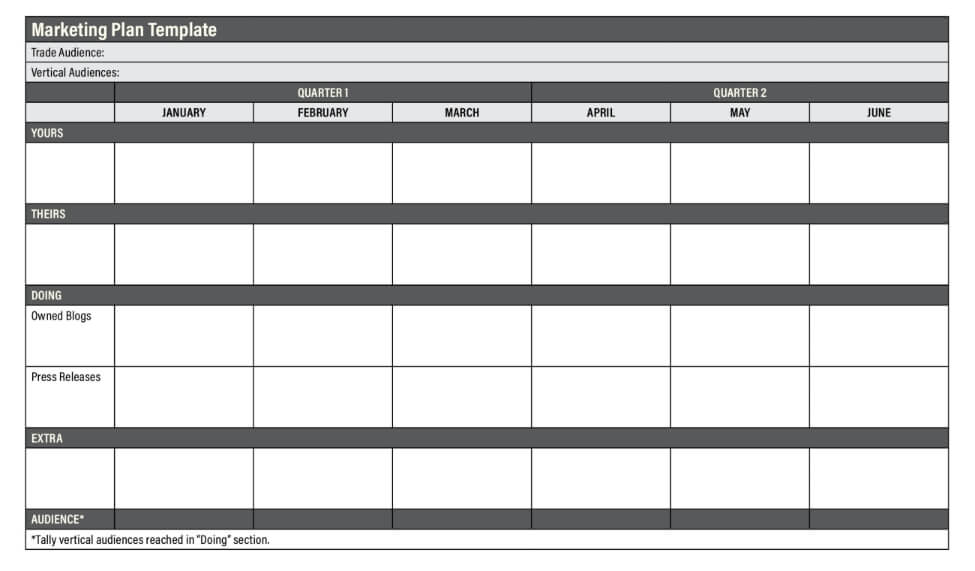
I have also included images of sample B2B and consumer marketing plans. To view them fully, while also getting more details about this process — including information on the audience section (not included in this post) — download the “Putting it All Together” chapter from my book for free.
Once you’re done with this exercise, you’ll leave with the first tab of your owned and earned marketing plan completed. Then, you can layer your approach by adding supplemental tabs as you work. For example, add a speaking tab as you come across potential thought leadership opportunities, a media contact tab as you read pertinent news articles, and a daily social media calendar.
1. Start With Yours
When you’re staring at a blank page, don’t worry about inventing clever ideas out of thin air. Instead, begin with what’s already happening in your organization. We call this “Yours.”
Ask yourself:
- What’s happening right now?
- What will be happening a few months from now?
- What’s coming six months to a year out?
Examples: new product launches, service updates, leadership announcements, anniversaries or expansions. These are the raw materials of your marketing calendar.
📌 Pro tip: If you know the rough month for something, put it in your calendar right away. If not, keep a running list and drop items in their assigned months as they become clearer.
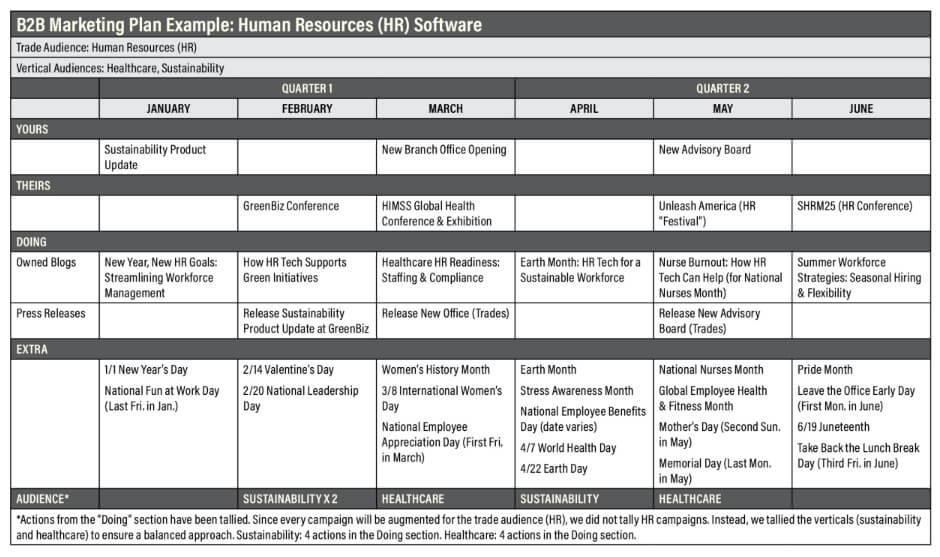
2. Layer in Theirs
Once you’ve captured what’s new with you, look outward. “Theirs” is about what your audience cares about.
Ask:
- What industry events or trade shows are coming up?
- What community happenings would your audience attend or talk about?
Even if your organization doesn’t participate, you can still time activity around what’s happening. For example:
- Pitch a press release to coincide with a major conference
- Post on social media about a local event your customers care about
📌 Pro tip: Don’t try to be perfect on the first pass. Create a messy list of potential events in a Google Doc, then refine it into your plan.
3. Add in Extra
This is where your plan gets fun. “Extra” is for quirky dates, seasonal themes and observances that keep content fresh.
Tools like National Day Calendar are goldmines for this. Some days are silly (hello, National Donut Day) but others are powerful touchpoints: Breast Cancer Awareness Month, Earth Day or back-to-school season.
Adding these dates isn’t about filling your feed with fluff. It’s about giving you timely angles to make your content and pitches more relevant. For instance:
- A chocolatier might build Valentine’s Day into their media outreach
- A fitness brand might tie blog posts to New Year’s resolutions
- A lighthearted post on National Coffee Day could keep your social pipeline flowing
The Extra column serves as a reminder: when you’re planning, you always have a pool of timely hooks to draw from.
4. Turn to Doing
Now comes the critical step: action. Without action, your calendar is just a list of good intentions. The “Doing” section is where you spell out exactly what you’ll do with the items from the Yours, Theirs and Extra sections.
This is also where timing matters. It’s not enough to mark when something happens, you need to map out when to start working on it. Media deadlines are often months ahead of publication dates. Seasonal campaigns take weeks to build. The Doing section ensures you’re working ahead, not scrambling at the last minute.
We focus on two core categories:
- Media Outreach: You don’t need to perform media outreach on a monthly basis. Once a quarter may be enough, or you can increase frequency based on news. Add rows for editorial calendars, bylined articles or big announcements — and note when the prep work should begin.
- Owned Content: Publishing at least one piece of content each month (like a blog post, podcast or video) is non-negotiable for SEO and GEO. From there, repurpose. We typically create three distinct social posts for each blog. Plan not just the publish date, but when you’ll draft, review and schedule it.
📌 Pro tip: Use formatting (like color coding) to mark “work start” dates vs. “publish dates.” That way, your calendar shows both deadlines and the ramp-up needed to hit them.
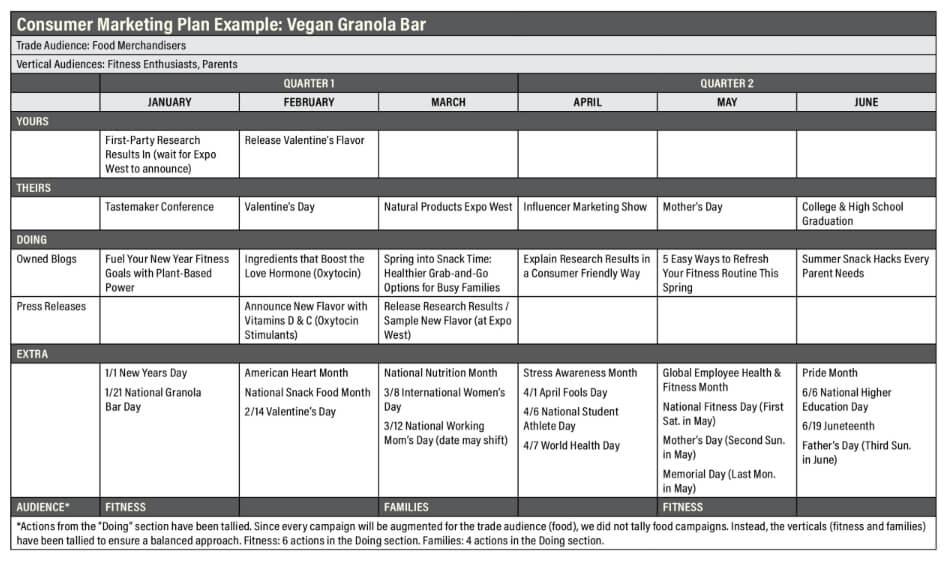
Tools That Make Planning Easier
You don’t have to be married to a single tool to build your calendar — what matters is consistency. Here are a few approaches that work well for teams of different sizes:
- Google Sheets or Excel: Simple, sharable and customizable. Perfect for small teams who want to see everything in one place.
- Project Management Tools (Asana, Monday, Trello): Great if you want built-in reminders, task assignments and collaboration features.
- Calendar Overlays (Google Calendar, Outlook): Ideal for visual thinkers who like to see marketing deadlines alongside other business activities.
No matter what you use, the structure (Yours, Theirs, Extra, Doing) can carry over. That’s what makes this framework so flexible — it adapts to your workflow, not the other way around.
Repurposing in Action
One of the biggest advantages of a marketing calendar is spotting opportunities to repurpose. For example:
- A single blog post → becomes a newsletter feature → plus three social posts → plus a pitch angle for local media
- An industry event → becomes a thought leadership LinkedIn post → plus recap blog → plus customer-facing email
Instead of scrambling for content every week, you’re stretching the value of each effort. This is how smaller teams punch above their weight: by letting one piece of work ripple outward across multiple channels.
Closing Insight: Simple Wins
It’s tempting to over-engineer your calendar with dozens of sections, categories and color codes. But complexity often leads to paralysis. The most effective plans are simple, flexible and actionable.
This framework gives you just enough structure to stay consistent without drowning in detail. Over time, you’ll refine the process, build confidence and spot patterns that help you plan smarter.
Remember: a calendar isn’t just about organization — it’s about momentum. Every post, pitch and piece of content is a building block toward visibility and trust. Start small, keep it flexible and let your plan grow with you.
Ready to Build Yours?
You’re welcome to use the PR Planning Template to map out your first tab and layer in Yours, Theirs, Extra and Doing.
If you’d like more information — and to see the full B2B and consumer plans — download the “Putting it All Together” chapter from A Practical Guide to Public Relations for Businesses, Nonprofits and PR Leaders. You’ll also get more insight on how to select audiences and pair them with the campaigns listed in your plan.

